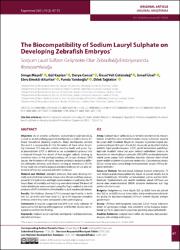The biocompatibility of sodium lauryl sulphate on developing zebrafish embryos

Göster/
Erişim
info:eu-repo/semantics/openAccessAttribution-NonCommercial 4.0 Internationalhttps://creativecommons.org/licenses/by-nc/4.0/Tarih
2021Yazar
Meşeli, SimgeKaplan, Gül
Cansız, Derya
Üstündağ, Ünsal Veli
Ünal, İsmail
Emekli Alturfan, Ebru
Yanıkoğlu, Funda
Tağtekin, Dilek
Üst veri
Tüm öğe kaydını gösterKünye
Meşeli, S., Kaplan, G., Cansız, D., Üstündağ, Ü. V., Ünal, İ. ve Emekli Alturfan, E. (2021). The biocompatibility of sodium lauryl sulphate on developing zebrafish embryos. Experimed, 11(2), 67-72. https://dx.doi.org/10.26650/experimed.2021.953435Özet
Objective: As an anionic surfactant, sodium lauryl sulphate (SLS), is used as an emulsifying agent in toothpastes as well as many different household cleaning products. Many toothpastes contain SLS and it is responsible for the formation of foam when brushing. However SLS may also irritate sensitive teeth and gums. Lipid peroxidation (LPO) is defined as an autoxidation process that is induced through the attack of free oxygen radicals leading to oxidative stress in the pathophysiology of various diseases. LPO causes the formation of highly reactive products including different aldehydes, ketones, and alkanes serving as biomarkers of LPO. In our study we aimed to expose zebrafish embryos to SLS and determine LPO in SLS exposed zebrafish embryos. Material and Method: Zebrafish embryos that were dividing normally and which had spherical shapes were chosen and they were exposed to SLS both in low and high concentrations in well plates for 72 hours. Rates of mortality and hatching were determined. The levels of malondialdehyde were evaluated using the Yagi's method as the end products of LPO in the form of thiobarbituric acid reactive substances. Results: Our findings showed LPO increased significantly in both low SLS (p<0.05) and high dose SLS (p<0.05) exposed zebrafish embryos when they were compared to the control group. Conclusion: It may be suggested that LPO is an early indicator of exposure to SLS during embryogenesis and further studies are required to confirm this finding. Amaç: Sodyum lauril sülfat (SLS), ev temizlik ürünleri ve diş macunlarında emülsifiye edici temizlik maddesi olarak kullanılan anyonik bir yüzey aktif maddedir. Birçok diş macunu fırçalarken köpük oluşumuna yol açan SLS içerir. Ancak SLS hassas diş ve diş etlerini tahriş edebilir. Lipid peroksidasyonu (LPO), çeşitli hastalıkların patofizyolojisinde oksidatif strese yol açan serbest radikallerin saldırısı ile başlatılan bir otooksidasyon sürecidir. LPO, LPO'nun biyobelirteçleri olarak görev yapan farklı aldehitler, ketonlar, alkanlar dahil olmak üzere reaktif ürünlerin oluşumuna neden olur. Çalışmamızın amacı, SLS'ye maruz kalan zebra balığı embriyolarında oluşan LPO'yu değerlendirmektir. Gereç ve Yöntem: Normal olarak bölünen küresel embriyolar, 72 saat boyunca plaka kuyucuklarında düşük ve yüksek dozda SLS'ye maruz bırakılmıştır. Mortalite ve kuluçkadan çıkma oranları belirlenmiştir. Tiyobarbitürik asit reaktif maddeler olarak LPO'nun son ürünü olan malondialdehit (MDA) düzeyini belirlemek için Yagi yöntemi kullanılmıştır. Bulgular: Bulgularımız, hem düşük SLS (p<0,05) hem de yüksek doz SLS’ye (p<0,05) maruz kalan zebra balığı embriyolarında kontrol grubu ile karşılaştırıldığında LPO'nun önemli ölçüde arttığını göstermiştir. Sonuç: LPO'nun embriyogenez sırasında SLS'ye maruz kalmanın erken bir göstergesi olduğu öne sürülebilir ve bu bulguyu doğrulamak için farklı çalışmaların yapılması gerektiği düşünülmektedir.
Kaynak
ExperimedCilt
11Sayı
2Koleksiyonlar
- Makale Koleksiyonu [3809]
- TR-Dizin İndeksli Yayınlar Koleksiyonu [2179]


















